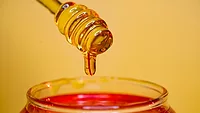Researchers Develop New Honey Authentication Techniques to Combat Pervasive Adulteration

Image credit: Mae Mu via Unsplash
DNA barcoding and spatial offset Raman Spectroscopy (SORS) are technologies that show promise for the detection of sugar adulterants in honey, as demonstrated by two recent studies. The work was supported by the UK Food Standards Agency (FSA) and UK Research and Innovation (UKRI), and was conducted by researchers from Cranfield University, the Institute for Global Food Security at Queen’s University of Belfast, and FSA.
Honey Adulteration in Europe
Honey is a commonly adulterated product. In a 2023 investigation, the European Food Safety Authority (EFSA) found 46 percent of honey imported to the EU to be adulterated. Detecting adulterated honey is difficult due to the broad range of honey characteristics that vary due to nectar sources, harvest season, and location of origin.
Governments are making efforts to combat honey fraud; since the results of EFSA’s investigation were released, the UK has developed a protocol for the collection of honey reference samples for the creation of authenticity databases.
Additionally, the EU is in the process of forming an expert “Honey Platform” to advise the European Commission on traceability rules for honey, and to introduce standardized methods for honey adulteration detection and origin tracing.
Non-Invasive SORS
Using light, SORS enables the highly accurate chemical analysis of objects beneath obscuring materials. The technique was originally developed at UKRI’s Science and Technology Facilities Council’s Central Laser Facility (STFC’s CLF), and it is already used for analysis in pharmaceutical and security applications. Without opening product, the technique can determine the composition of honey through its packaging.
For the study, 17 types of honey spiked with rice and sugar beet syrups were subjected to SORS. The best-performing algorithm for classification only misclassified one percent of the pure honeys as adulterated, and less than 3.5 percent of adulterated honeys as pure. This algorithm was further employed to create a classification model that successfully classified samples according to the type of adulterant (rice or sugar beet) and the adulteration level.
Looking for quick answers on food safety topics?
Try Ask FSM, our new smart AI search tool.
Ask FSM →
The results demonstrated the potential of SORS, in combination with machine learning, to rapidly check the authenticity of honey samples and the detection of any added sugar syrups.
DNA Barcoding
DNA-based methods are commonly used for food authentication; specifically, identifying plant species in various food products. In honey, multiple DNA from floral sources, microbes, and honeybees are present, but DNA-based approaches have mainly focused on verifying botanical origins and have not been widely used to examine honey authenticity. In this context, the study aimed to develop a DNA barcoding method to detect exogenous sugar adulteration in honey in real-world conditions, focusing on rice, corn, and sugar beet syrup.
The researchers collected 17 honey samples from UK bee farmers, representative of different seasons and botanical sources, as well as four domestic honey samples purchased at retail. Corn and rice syrups originating from various countries were used to spike the honey samples.
A specialized DNA barcoding method involving specific DNA markers and qualitative polymerase chain reaction (qPCR) analysis was developed—and was able to successfully characterize the composition of each sample to detect honey adulteration at levels as low as one percent. Alongside current screening methods, the DNA barcoding method employed in the study could be used as a robust test alongside current honey screening methods to help confirm product authenticity and identify the plant origins of adulterant material.








.webp?t=1721343192)
